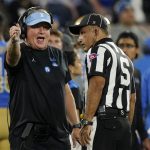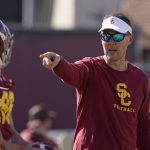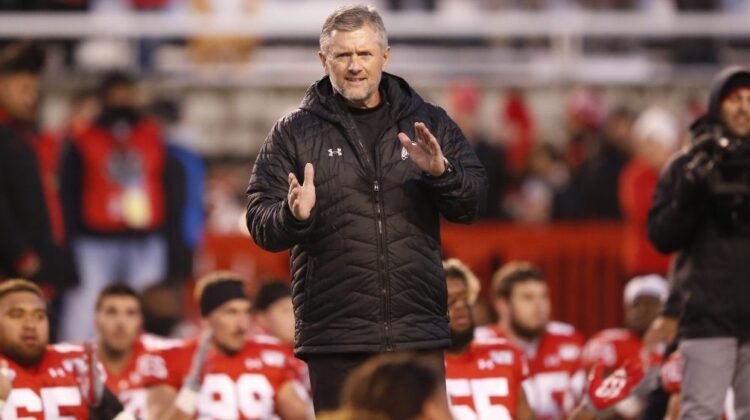The Hotline mailbag publishes weekly. Send questions to pac12hotline@
Please note: Some questions have been edited for clarity and brevity.
Assuming that Utah coach Kyle Whittingham steps away in the not-too-distant future, defensive coordinator Morgan Scalley probably will take over. When other programs have replaced a legend with a key existing staff member, what are some best and worst comparisons? And which might be closest to Utah’s case? — @mattkreuter
We agree that the 64-year-old Whittingham will retire in the next few years and Scalley, the longtime defensive assistant and coordinator, will take over the program.
At one point, Scalley was the official coach-in-waiting, but that designation was revoked after he used a racial slur in a text message. Our sense is that enough time has passed without further incident (or additional revelations) that the Utes could promote Scalley to the throne without significant political fallout.
The comparison that comes immediately to mind — because it happened just a few years ago, not because Utah is destined for the same fate — is Washington promoting Jimmy Lake to replace Chris Petersen in December 2019. That ended poorly, with Lake dismissed after two seasons.
There’s a rough comparison available down the road from Salt Lake City, as well: In 2001, Brigham Young replaced legendary coach LaVell Edwards with Gary Crowton. Although Crowton wasn’t on Edwards’ staff at the time of the transition, he was a BYU alum. Crowton had a stellar first season, then fizzled.
If we expand the scope in both time and terrain, more comparisons come into focus.
Oklahoma replaced Barry Switzer with defensive coordinator Gary Gibbs in 1989. Gibbs cleaned up the mess left behind and lasted six seasons but did not win at the required level.
In 1993, Washington defensive coordinator Jim Lambright was promoted to head coach after UW legend Don James resigned in August amid an NCAA scandal. Lambright lasted six years, never cracking the top 10 in the final AP poll.
In 1998, longtime Nebraska assistant Frank Solich took over for Tom Osborne and averaged 10 wins over four seasons. But success faded in Year Five and Solich was gone soon after.
So there are myriad situations similar to a Scalley-for-Whittingham exchange. In many cases the replacement experienced early success, then lost traction.
And the timelines are shorter these days. In the 1990s, it was common to give coaches five or six seasons. Now, judgment comes after Year Three, if not sooner.
In our view, Oregon offers the best model for Utah. Somehow, the Ducks made internal promotions work twice:
— Offensive coordinator Mike Bellotti replaced Rich Brooks in 1995 and lifted the program to unprecedented heights over the course of his 14 seasons.
— Bellotti then stepped aside before the 2009 season and handed the keys to his playcaller, Chip Kelly, who led the Ducks to 46 wins in four years (and transformed the sport in the process).
None of the aforementioned situations is exactly like Utah’s presumed transition, and the sport is changing dramatically, with economics (e.g., NIL) playing an increasingly large role in roster composition.
Our advice to Utah fans wondering about the post-Whittingham existence: Take comfort in Utah’s previous success.
After all, Whittingham himself was an internal promotion after Urban Meyer left for Ohio State in 2004, and that transition worked out pretty darn well.
Do you predict the eight most valuable football schools form an alliance in the coming years in order to leverage the highest media rights payouts? If such an alliance forms, will USC be included among the eight? — @TerryTerry79
The Trojans would probably make the cut for a Great Eight, although it’s close. Notre Dame, Ohio State, Michigan, Penn State, Texas, Oklahoma, Georgia, Alabama and LSU would be in the discussion, as well.
But we don’t see any indication of an eight-school alliance.
How would that function on a practical level? You need more than eight to create a super league. And how would those eight leverage their media valuation separately given that they are currently under contract (for varying lengths) with their conferences.
The super league concept currently making the rounds is deeply flawed and features 80 schools. That isn’t realistic: Fox and ESPN would not agree to pay premium valuations for Minnesota vs. South Carolina or TCU vs. Arizona.
If massive consolidation materializes, the super league that emerges will have fewer than 80 schools … but far more than eight.
Have Fox and the Big Ten identified the 2024 football games that will be moved to Friday? It’s difficult to make travel plans to attend away games when there is a risk that the game will be moved to a different day. — @Jalex0077
The Friday games have added a layer of complication for fans, and the situation is only getting worse with the increased travel (time and cost) required in bicoastal conferences.
The 2024 Big Ten schedule, released in November, included the following note:
“Selected Saturday games in the 2024 season may be adjusted to select Fridays and other special dates, including Labor Day Sunday and Black Friday.”
Look for the conference to announce a slew of Friday matchups at the end of May, along with the kickoff times for its early-season (non-conference) games.
Our hunch: A significant number of the Friday dates, if not the majority, will involve West Coast schools.
Are the former Pac-12 teams still going to participate in the bowl games tied to the former conference as speculated several months ago? — @tobsandmags
As we see it, there is no viable alternative. The new homes for the outbound schools (ACC, Big Ten and Big 12) have bowl contracts based on current membership.
Granted, tweaks will be needed to avoid rematches. For instance, the Alamo Bowl pairs the No. 2 team in the Pac-12 with an opponent from the Big 12. Nobody wants Utah playing Iowa State in San Antonio one month after the teams collide in Salt Lake City.
Also, the bowl partnerships are based largely on geography.
Keeping the outbound Pac-12 teams aligned with Pac-12 bowls in the Pacific Time Zone — unless those teams make the cut for the playoff — creates the most cost-effective experience for fans.
With the House lawsuit against the NCAA, shouldn’t more blame and cost be on Arizona State since that’s the institution House swam for? — @bdgiddens6
I cannot help but chuckle and wonder if the author of this question is an Arizona fan, seeking a way to denigrate the Sun Devils.
For those unfamiliar, Grant House is a former ASU swimmer and the named plaintiff in a lawsuit that is transforming college sports by forcing the schools into a revenue-sharing agreement with athletes.
House v NCAA is scheduled for trial next winter but could be settled in the next few months, with a steep price tag.
ESPN and Yahoo have reported the NCAA could owe former athletes almost $3 billion in compensation from the pre-NIL era.
Additionally, schools are preparing to spend about $20 million annually in revenue sharing with current athletes and another $10 million in additional scholarships.
The totality of the cost could force some schools to eliminate Olympic sports or decide they don’t want to compete at the highest level of major college football.
But Grant House’s choice of colleges should not require ASU to carry a larger financial burden. The Sun Devils didn’t subject him to different economic conditions than existed for Olympic sports athletes across the country.
What’s your pick for Colorado’s opener against North Dakota State? And what happens in Boulder when the Bisons beat the Buffaloes? — @PDX_JonathanW
NDSU is one of the top programs in the FCS and, over the years, has defeated a slew of major college teams.
That said, we’re picking the Buffaloes. They should be marginally better than they were last season with improved play on the lines of scrimmage.
But a loss to NDSU would create an exceedingly difficult path into the postseason for second-year coach Deion Sanders.
CU’s conference schedule is daunting with Arizona, Utah and both Kansas schools, while the non-conference lineup again includes Nebraska and Colorado State in September.
How much longer does “Coach Prime” last at Colorado? — @CyclingUte22
We have considered Sanders a short-timer in Boulder since the moment he accepted the job in December 2022. Either he wins this year or next and leaves for a better job, or he flops and resigns.
His recent comments about not following his sons into the NFL are immaterial, in our view.
Even if Sanders wants no part of coaching on Sundays, he would surely entertain offers from his alma mater, Florida State, or an elite college program in the SEC.
Put another way: We would be mildly surprised if he’s coaching the Buffaloes in their 2026 season opener.
Will Brigham Young’s victory total be over or under four in the upcoming season? I’m going with the under. — @utez1568052
Given that FanDuel set BYU’s win total at 4.5, your lean seems reasonable.
[related_articles location=”left” show_article_date=”false” article_type=”automatic-
The Hotline pegged the Cougars for 13th place in the Big 12 race next season because of the quarterback uncertainty and a wobbly run defense.
But the schedule cannot be ignored, either.
Winning on the road is always difficult. When the home lineup is daunting, as well, the overall margin for error shrivels.
And BYU has one of the toughest home schedules in the Big 12 with Kansas, Kansas State, Arizona and Oklahoma State visiting Provo.
I’m not sure about your projection of fewer than four victories, but we certainly would take under FanDuel’s total of 4.5.
Any developing news on the fate of the Pac-12 Network? — @rEd315
That depends on what you already know.
The Pac-12 Networks will cease to exist as a media distribution company on July 1. However, the infrastructure will remain in place to produce live events for Washington State and Oregon State in 2024-25.
The schools have numerous teams competing as affiliate members of the West Coast Conference and are thereby subject to the WCC’s media requirements. Those include making dozens of competitions available for broadcast on ESPN’s digital platform.
The Pac-12 Networks’ equipment and production staff will carry the load for WSU and OSU, at least for the upcoming year.
After that? The conference has a multi-year lease on the San Ramon office space. But like so much else, that issue is unresolved.
*** Send suggestions, comments and tips (confidentiality guaranteed) to pac12hotline@bayareanewsgroup.
*** Follow me on Twitter/X: @WilnerHotline
*** Pac-12 Hotline is not endorsed or sponsored by the Pac-12 Conference, and the views expressed herein do not necessarily reflect the views of the Conference.
Related posts:

(AP Photo/Mark J. Terrill)
Wilner Hotline – UCLA Clarity with Kelly Staying, Unreal Uptick in Tucson, more…
(AP Photo/Ralph Freso, File)
Hotline Mailbag – Breaking down Utah-Florida and Oregon-Georgia, Shaw’s job security and more
Southern California head coach Lincoln Riley (AP Photo/Mark J. Terrill)
Wilner Hotline – Pac-12 Stock Up, Stock Down. Lincoln Riley the lightning rod Wilner Hotline – Pac-12 football 2022 win totals: Our breakdown of the schedules
Wilner Hotline – Pac-12 football 2022 win totals: Our breakdown of the schedules


